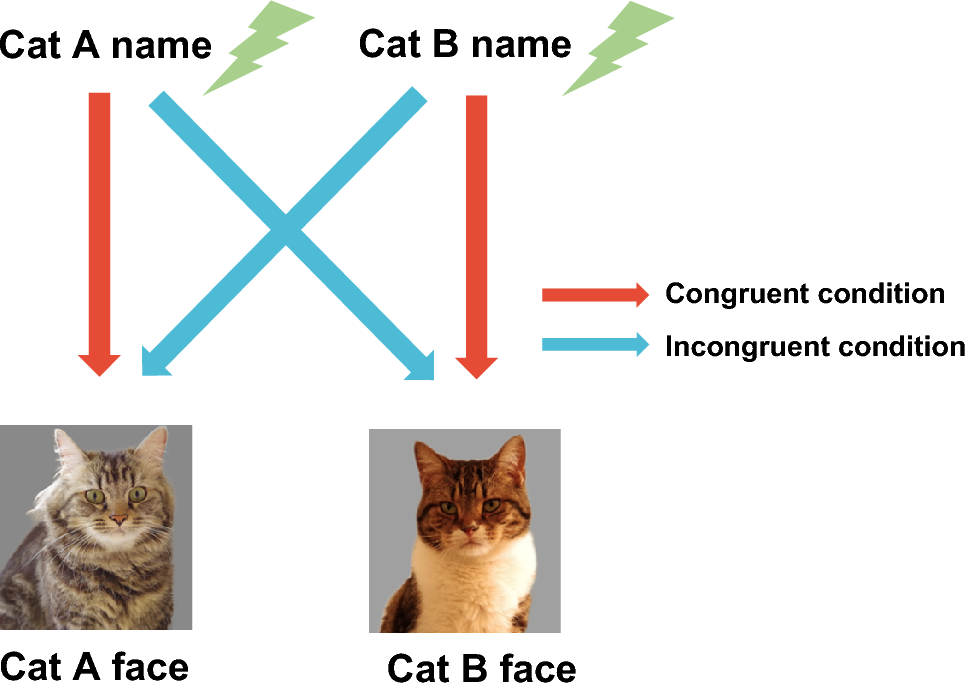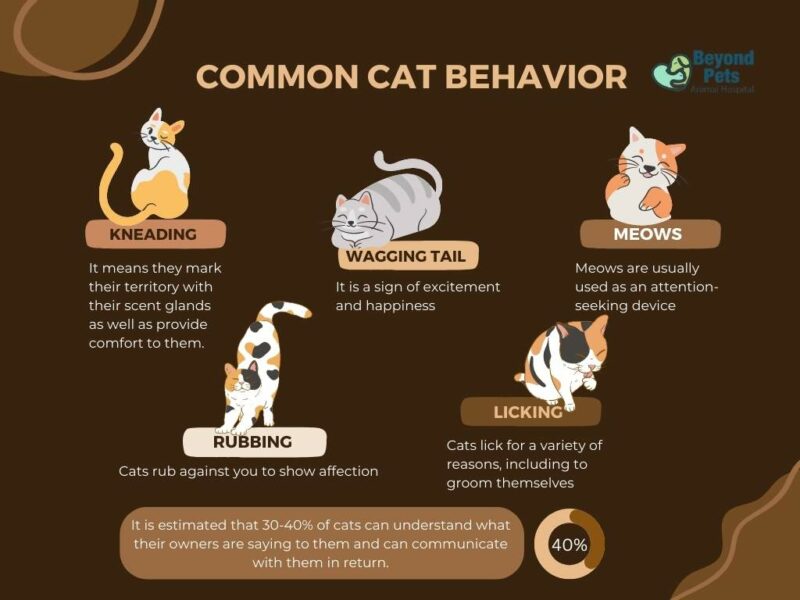Understanding common cat behaviors can help owners better understand their pets. Cats’ playful nature, socializing preferences, and sleeping habits all provide insight into their behavior.
Understanding these behaviors can help owners create a suitable environment for their feline friends, leading to a happier and healthier relationship between pet and owner. Additionally, recognizing signs of distress or aggression in cats can aid in addressing any potential issues.
By observing and comprehending these behaviors, cat owners can foster a deeper understanding of their pets and ensure their well-being.

Credit: www.nature.com
Deciphering Feline Mystique
Understanding cat behavior is crucial for pet owners to ensure their feline friends are happy and healthy. Cats communicate through various behaviors that may seem mysterious at first glance. Deciphering these behaviors can strengthen the bond between owners and their pets.
The Enigma Of Purring
Cats purr when they are content, but they may also purr when they are stressed or in pain. It’s a form of self-soothing and communication. Understanding the context and body language accompanying the purring can help decipher its meaning.
Chattering: A Hunter’s Quirk
Cats often make a chattering noise when they see birds or small prey. This behavior stems from their natural hunting instincts. They are expressing frustration or excitement at the sight of potential prey, a behavior that connects them to their wild ancestors.
Communicative Tails And Whiskers
Understanding cat behavior is crucial for pet owners. Communicative tails and whiskers reveal a lot about their moods. Cats communicate through body language, such as purring when happy or swishing their tails when agitated. Recognizing these behaviors helps owners better understand and care for their pets.
Understanding Cat Behavior: Communicative Tails and Whiskers Cats communicate using various body signals, including their tails and whiskers. Understanding these signals can help pet owners better understand their feline companions and improve their bond. Here, we’ll decode the messages behind tail signals and whisker movements to help you interpret your cat’s behavior more accurately.Tail Signals Decoded
Cats use their tails to convey a range of emotions and intentions. A tail held high indicates a friendly, confident cat, while a fluffed-up tail suggests fear or aggression. A slow swishing tail may indicate uncertainty or excitement, while a rapidly thrashing tail signals irritation or agitation. Paying attention to your cat’s tail movements can offer valuable insights into their current state of mind.Whisker Messages
Whiskers are highly sensitive and serve as a crucial communication tool for cats. When a cat’s whiskers are relaxed and pointing forward, it indicates contentment and relaxation. However, when the whiskers are pulled back tightly against the face, it can signal fear, anxiety, or aggression. Understanding these subtle signals can help owners respond appropriately to their cat’s needs and emotions. By paying attention to these communicative cues, cat owners can develop a deeper understanding of their pet’s behavior and strengthen their bond with their feline companions.Ears And Eyes: Silent Speech
When it comes to understanding our feline friends, their ears and eyes play a crucial role in communicating their feelings and intentions. Cats have mastered the art of silent speech through their ear positions and eye contact. By learning to decipher these signals, cat owners can better understand their pets and strengthen their bond. In this article, we will explore the meanings behind different ear positions and the significance of eye contact in cat behavior.
Ear Positions And Their Meanings
- Forward-facing ears: Express interest and curiosity.
- Sideways and backward ears: Indicate arousal or distress.
- Backward ears with a hiss or swipe: Signify feeling threatened or displeased.
The Look Of Love: Eye Contact
Eye contact is a powerful form of communication in the feline world. When your cat maintains eye contact with you, it signifies trust and affection. It is their way of saying, “I feel safe and comfortable around you.” On the other hand, prolonged staring or dilated pupils can indicate aggression or fear. It is important to pay attention to your cat’s eye contact and respond accordingly to ensure their well-being.

Credit: www.amazon.com
Feline Playtime And Predatory Behavior
Cats’ playtime and predatory behavior are common aspects of feline behavior. Understanding these behaviors can help owners better connect with their pets. Recognizing their playfulness and hunting instincts can also aid in providing appropriate toys and activities to keep them engaged and content.
of a cat during playtime and predatory behavior? Let’s explore some common cat behaviors and what they mean.Interactive Games
Cats love interactive games that stimulate their natural instincts. These games help keep them physically active and mentally stimulated. Interactive toys, such as feather wands or laser pointers, can mimic prey and engage your cat in a playful chase. It’s important to provide a variety of interactive games to keep your cat entertained and prevent boredom.Indoor ‘hunting’
Indoor ‘hunting’ is a common behavior among cats, especially those that do not go outside often. When cats engage in indoor hunting, they may stalk, pounce, and chase after toys or objects around the house. This behavior allows them to fulfill their natural predatory instincts and release excess energy. Providing your cat with toys that resemble small prey, such as mice or birds, can help satisfy their hunting instincts. During playtime and predatory behavior, it’s essential to observe your cat’s body language. Dilated pupils, a puffed-up tail, and crouching posture indicate excitement and readiness to pounce. It’s important to let your cat have fun during playtime, but also ensure their safety by avoiding games that encourage aggressive behavior, such as biting or scratching. In conclusion, understanding your cat’s playtime and predatory behavior is crucial for building a strong bond with your pet. By providing interactive games and opportunities for indoor ‘hunting,’ you can fulfill their natural instincts and keep them physically and mentally stimulated. Remember to always observe your cat’s body language and provide a safe and enriching environment for playtime.Cat Naps: More Than Just Sleep
Cat Naps: More Than Just Sleep dives into understanding common cat behaviors and their meanings, helping owners better comprehend their furry companions. From playfulness to sleeping patterns, this article sheds light on various aspects of cat behavior.
ow? Cat Naps: More Than Just Sleep Cats are notorious for their long naps throughout the day. In fact, it is not uncommon for a cat to sleep for up to 16 hours a day! However, these naps are not just for sleeping; they serve various purposes that are crucial to the cat’s wellbeing. Understanding your cat’s snoozing patterns and the perfect spot they choose to nap can give you insight into their behavior. Snoozing Patterns Cats have a unique sleeping pattern, which is different from that of humans. They alternate between light sleep and deep sleep, and their naps can range from a few minutes to several hours. During their light sleep, cats can still be alert to their surroundings, and they can easily wake up at the slightest noise or movement. On the other hand, during their deep sleep, cats are completely relaxed, and it can be challenging to wake them up. Choosing The Perfect Spot Cats are very particular when it comes to choosing the perfect spot to nap. They usually prefer cozy and warm areas, such as sunbeams, laps, and soft blankets. Cats also like to sleep in high places, such as the top of a bookshelf, to keep an eye on their environment. It is essential to ensure that your cat has a comfortable and safe place to nap to prevent any injuries. Understanding your cat’s napping patterns and preferences can help you provide a comfortable and safe environment for them. Additionally, it can help you identify any changes in their behavior that might indicate illness or discomfort. So, next time your cat takes a nap, observe their behavior and sleeping habits to gain insight into their wellbeing.
Credit: www.rd.com
Territorial Tendencies In Cats
Cats have territorial tendencies and can become aggressive towards other cats or animals that enter their space. It is important for owners to understand their cat’s behavior and provide them with their own space to avoid conflicts. Recognizing and addressing territorial behavior can lead to a happier and healthier relationship between owners and their pets.
Territorial Tendencies in Cats Cats are known for their territorial nature, which is an innate behavior. They have a strong sense of ownership and will mark their territory to claim it. Understanding your cat’s territorial tendencies can help you better understand your pet and create a comfortable home environment for them. Marking territory Cats mark their territory by spraying urine or rubbing their scent glands on objects, such as furniture, walls, and doors. This behavior is more common in unneutered males, but females may also exhibit it. By marking their territory, cats communicate with other cats and assert their dominance. Sharing space with humans and other pets Cats have a strong attachment to their owners and may show territorial behavior towards other pets in the household. They may become aggressive or defensive to protect their space and resources, such as food and toys. It’s important to introduce new pets gradually and provide separate feeding and sleeping areas to avoid conflicts. To prevent territorial issues, provide plenty of vertical space and hiding spots for your cat. This can include cat trees, shelves, and enclosed spaces where they can retreat when they feel threatened. Also, make sure your cat has access to their own litter box and food and water bowls. In conclusion, understanding your cat’s territorial tendencies can help you create a comfortable and harmonious home environment for your pet. By providing plenty of resources and space, you can help your cat feel secure and reduce the likelihood of territorial conflicts.Aggression Vs. Affection
Understanding cat behavior is crucial for pet owners. Aggression, often a defensive response, can be triggered by fear or stress. On the other hand, affectionate behaviors such as head-butting and purring indicate contentment and trust. Recognizing these cues helps owners understand their feline companions better.
Reading Signs Of Aggression
Understanding your cat’s behavior is crucial for building a strong bond with your feline friend. One aspect of cat behavior that owners often struggle to decipher is the difference between aggression and affection. Cats may display aggressive behavior when they feel threatened or stressed, and it’s important to recognize the signs before the situation escalates.
1. Body language: Pay close attention to your cat’s body language. An aggressive cat may have dilated pupils, a stiff body, and an upright tail. They may also hiss, growl, or arch their back as a warning sign.
2. Tail position: A cat’s tail can be a good indicator of their mood. If the tail is puffed up or wagging rapidly, it may be a sign of aggression. Conversely, a relaxed and low-hanging tail usually indicates a content and affectionate cat.
3. Vocalization: Aggressive cats may make loud, threatening vocalizations such as hissing, growling, or yowling. These sounds are meant to intimidate and warn potential threats.
4. Defensive postures: When feeling threatened, cats may adopt defensive postures such as crouching low to the ground, flattening their ears against their head, or showing their teeth. These behaviors are clear signs of aggression.
Understanding Affectionate Gestures
On the other hand, it’s equally important to recognize the signs of affection in your cat. Understanding these gestures will help you strengthen the bond with your furry companion.
1. Purring: One of the most common signs of affection in cats is purring. This gentle rumbling sound usually indicates contentment and relaxation. Cats may purr when they are being petted, cuddled, or simply feeling happy.
2. Kneading: If your cat kneads you with their paws, it’s a sign of affection. This behavior is reminiscent of the kneading motion kittens make while nursing, and it shows that your cat feels safe and comfortable with you.
3. Head bunting: Cats often express their affection by gently rubbing their head against you. This behavior, known as head bunting, is a way for cats to mark you with their scent and show that they trust and consider you a part of their social group.
4. Slow blinking: When your cat looks at you and slowly blinks, it’s a sign of trust and affection. Known as a “cat kiss,” this gesture indicates that your cat feels safe and relaxed in your presence.
By understanding the difference between aggression and affection in cats, you can better respond to their needs and create a harmonious environment for both you and your feline companion.
Managing Misunderstood Behaviors
Understanding cat behavior is crucial for pet owners to manage misunderstood behaviors. By explaining common cat behaviors and their meanings, owners can better understand their pets, leading to a harmonious relationship. From playfulness to socialization, decoding cat behaviors fosters a deeper bond between humans and their feline companions.
Dealing With Unwanted Scratching
Unwanted scratching is a common behavior that many cat owners struggle with. While it can be frustrating to find your furniture or walls scratched up, it’s important to understand why cats engage in this behavior. Scratching is a natural instinct for cats, as it helps them keep their claws sharp and mark their territory. To manage unwanted scratching, here are a few tips:
- Provide your cat with appropriate scratching posts or boards. These should be tall enough for your cat to fully stretch and sturdy enough to withstand their scratching.
- Place the scratching posts in strategic locations around your home, near areas where your cat likes to scratch. This will encourage them to use the posts instead of your furniture.
- Use positive reinforcement by rewarding your cat with treats or praise when they use the scratching post. This will help reinforce the desired behavior.
- Trim your cat’s claws regularly to prevent them from causing too much damage when they scratch.
Addressing Litter Box Issues
Litter box issues can be a major headache for cat owners, but they are often a result of miscommunication between the cat and the owner. Cats are naturally clean animals and prefer to have a clean and private place to do their business. Here are some steps you can take to address litter box issues:
- Make sure you have enough litter boxes in your home. The general rule of thumb is to have one litter box per cat, plus one extra.
- Keep the litter box clean by scooping it daily and completely changing the litter at least once a week. Cats are less likely to use a dirty litter box.
- Choose a litter that your cat prefers. Some cats prefer a certain type of litter, so it may take some trial and error to find the right one.
- Place the litter box in a quiet and easily accessible area. Cats prefer privacy when using the litter box.
- If your cat continues to have litter box issues, it may be a sign of a medical problem. Consult with your veterinarian to rule out any underlying health issues.
By understanding and addressing these common cat behaviors, you can create a harmonious environment for both you and your feline friend. Remember, patience and positive reinforcement are key when managing misunderstood behaviors.
Frequently Asked Questions
What Is A Common Cat’s Behavior?
Most cats are playful and enjoy socializing with people. They like to play with toys and may hunt indoors. Some cats may be less sociable, especially if they live outdoors. Cats sleep for many hours each day. Understanding their body language can help to understand their behavior better.
How To Understand Cat Behavior?
To understand cat behavior, observe their body language. Forward-facing ears show interest, while swiveling ears indicate arousal or distress. Backward ears, hissing, or swiping mean they feel threatened. Cats are playful and sociable, but outdoor cats may be less friendly.
They sleep a lot and groom themselves frequently. Cats are most active at dawn and dusk, prefer clean litter boxes, and live longer indoors. Aggressive behaviors include crouching, flattened ears, hissing, and growling. Purring can indicate happiness or anxiety.
What Are Some Facts About Cats Behavior?
Cats are playful and sociable, enjoying toys and hunting indoors. They may be less sociable if they live outdoors. Cats sleep for many hours and are most active at dawn and dusk. They are fastidious about grooming and live longer when kept indoors.
Purring indicates happiness, while growling signals annoyance or aggression.
What Is The Behavior Of A Mean Cat?
A mean cat may show defensive aggression through body postures like crouching, flattening ears, and hissing. It’s important to understand these signs to avoid provoking the cat further. Understanding cat behavior is crucial for proper care and handling.
Conclusion
Understanding cat behavior is key to building a strong and lasting bond with your feline friend. By learning to interpret their body language and common behaviors, you can better understand their needs and feelings. Whether it’s playful antics, affectionate head-butts, or defensive hisses, each behavior has a meaning.
As cat owners, it’s our responsibility to provide them with a safe and comfortable environment, while also nurturing their natural instincts. By taking the time to understand their behavior, we can create a happy and healthy relationship with our furry companions.



